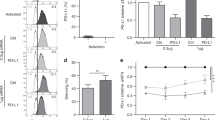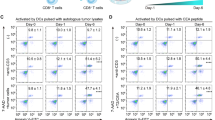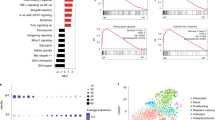Abstract
Adoptive cell therapy using tumor-specific T cells is a promising strategy for treating patients with malignancy. However, accumulating evidences have demonstrated that optimal function of tumor-reactive T cells is often attenuated by negative regulatory signal(s) delivered through receptors, such as cytotoxic T-lymphocyte antigen 4 (CTLA-4), programmed death 1 (PD-1), and their cognate ligands. Although systemic blocking of these molecules needs careful attention on the risk of uncontrolled immune activation, selective inhibition of negative signals in tumor-specific T cells by their genetic modification is an attractive approach to overcome immunological suppression in cancer patients. Here, we demonstrate the improved effector functions of tumor-specific CD4+ and CD8+ human T cells by small interfering RNA (siRNA) -mediated silencing of PD-1 ligands, PD-L1 or PD-L2. Tumor antigen MAGE-A4-specific human T-cell clones upregulated the expression of PD-1 ligands upon activation. siRNA-mediated knockdown of PD-L1 or -L2 enhanced the interferon-γ production and antigen-specific cytotoxicity of these cells. Peripheral blood mononuclear cells transduced with a retroviral vector encoding MAGE-A4-specific T-cell receptor α/β chains also increased their effector functions by this modification. These results suggest that siRNA-mediated knockdown of PD-1 ligands is an attractive strategy to inhibit a negative regulatory mechanism of tumor-specific T cells resulting in enhanced efficacy of adoptive T-cell therapy of cancer using genetically modified autologous lymphocytes.
This is a preview of subscription content, access via your institution
Access options
Subscribe to this journal
Receive 12 print issues and online access
$259.00 per year
only $21.58 per issue
Buy this article
- Purchase on Springer Link
- Instant access to full article PDF
Prices may be subject to local taxes which are calculated during checkout





Similar content being viewed by others
References
June CH . Adoptive T cell therapy for cancer in the clinic. J Clin Invest 2007; 117: 1466–1476.
Zitvogel L, Tesniere A, Kroemer G . Cancer despite immunosurveillance: immunoselection and immunosubversion. Nat Rev Immunol 2006; 6: 715–727.
Gattinoni L, Powell Jr DJ, Rosenberg SA, Restifo NP . Adoptive immunotherapy for cancer: building on success. Nat Rev Immunol 2006; 6: 383–393.
Stephan MT, Ponomarev V, Brentjens RJ, Chang AH, Dobrenkov KV, Heller G et al. T cell-encoded CD80 and 4-1BBL induce auto- and transcostimulation, resulting in potent tumor rejection. Nat Med 2007; 13: 1440–1449.
Greenwald RJ, Latchman YE, Sharpe AH . Negative co-receptors on lymphocytes. Curr Opin Immunol 2002; 14: 391–396.
Okazaki T, Iwai Y, Honjo T . New regulatory co-receptors: inducible co-stimulator and PD-1. Curr Opin Immunol 2002; 14: 779–782.
Zou W, Chen L . Inhibitory B7-family molecules in the tumour microenvironment. Nat Rev Immunol 2008; 8: 467–477.
Keir ME, Butte MJ, Freeman GJ, Sharpe AH . PD-1 and its ligands in tolerance and immunity. Annu Rev Immunol 2008; 26: 677–704.
Brown JA, Dorfman DM, Ma FR, Sullivan EL, Munoz O, Wood CR et al. Blockade of programmed death-1 ligands on dendritic cells enhances T cell activation and cytokine production. J Immunol 2003; 170: 1257–1266.
Dong H, Strome SE, Matteson EL, Moder KG, Flies DB, Zhu G et al. Costimulating aberrant T cell responses by B7-H1 autoantibodies in rheumatoid arthritis. J Clin Invest 2003; 111: 363–370.
Bennett F, Luxenberg D, Ling V, Wang IM, Marquette K, Lowe D et al. Program death-1 engagement upon TCR activation has distinct effects on costimulation and cytokine-driven proliferation: attenuation of ICOS, IL-4, and IL-21, but not CD28, IL-7, and IL-15 responses. J Immunol 2003; 170: 711–718.
Kuipers H, Muskens F, Willart M, Hijdra D, van Assema FB, Coyle AJ et al. Contribution of the PD-1 ligands/PD-1 signaling pathway to dendritic cell-mediated CD4+ T cell activation. Eur J Immunol 2006; 36: 2472–2482.
Kim YS, Park GB, Lee HK, Song H, Choi IH, Lee WJ et al. Cross-linking of B7-H1 on EBV-transformed B cells induces apoptosis through reactive oxygen species production, JNK signaling activation, and fasL expression. J Immunol 2008; 181: 6158–6169.
Dembic Z, Haas W, Weiss S, McCubrey J, Kiefer H, von Boehmer H et al. Transfer of specificity by murine alpha and beta T-cell receptor genes. Nature 1986; 320: 232–238.
Schmitt TM, Ragnarsson GB, Greenberg PD . T cell receptor gene therapy for cancer. Hum Gene Ther 2009; 20: 1240–1248.
Larin SS, Georgiev GP, Kiselev SL . Gene transfer approaches in cancer immunotherapy. Gene Therapy 2004; 11 (Suppl 1): S18–S25.
Rosenberg SA, Restifo NP, Yang JC, Morgan RA, Dudley ME . Adoptive cell transfer: a clinical path to effective cancer immunotherapy. Nat Rev Cancer 2008; 8: 299–308.
Miyahara Y, Naota H, Wang L, Hiasa A, Goto M, Watanabe M et al. Determination of cellularly processed HLA-A2402-restricted novel CTL epitopes derived from two cancer germ line genes, MAGE-A4 and SAGE. Clin Cancer Res 2005; 11: 5581–5589.
Hiasa A, Hirayama M, Nishikawa H, Kitano S, Nukaya I, Yu SS et al. Long-term phenotypic, functional and genetic stability of cancer-specific T-cell receptor (TCR) alphabeta genes transduced to CD8+ T cells. Gene Therapy 2008; 15: 695–699.
Okamoto S, Mineno J, Ikeda H, Fujiwara H, Yasukawa M, Shiku H et al. Improved expression and reactivity of transduced tumor-specific TCRs in human lymphocytes by specific silencing of endogenous TCR. Cancer Res 2009; 69: 9003–9011.
Roy M, Aruffo A, Ledbetter J, Linsley P, Kehry M, Noelle R . Studies on the interdependence of gp39 and B7 expression and function during antigen-specific immune responses. Eur J Immunol 1995; 25: 596–603.
Kato T, Hakamada R, Yamane H, Nariuchi H . Induction of IL-12 p40 messenger RNA expression and IL-12 production of macrophages via CD40-CD40 ligand interaction. J Immunol 1996; 156: 3932–3938.
Butte MJ, Keir ME, Phamduy TB, Sharpe AH, Freeman GJ . Programmed death-1 ligand 1 interacts specifically with the B7-1 costimulatory molecule to inhibit T cell responses. Immunity 2007; 27: 111–122.
Mirza N, Duque MA, Dominguez AL, Schrum AG, Dong H, Lustgarten J . B7-H1 expression on old CD8+ T cells negatively regulates the activation of immune responses in aged animals. J Immunol 2010; 184: 5466–5474.
Messal N, Serriari NE, Pastor S, Nunes JA, Olive D . PD-L2 is expressed on activated human T cells and regulates their function. Mol Immunol 2011; 48: 2214–2219.
Nourry C, Grant SG, Borg JP . PDZ domain proteins: plug and play! Sci STKE 2003; 2003: RE7.
Borkner L, Kaiser A, van de Kasteele W, Andreesen R, Mackensen A, Haanen JB et al. RNA interference targeting programmed death receptor-1 improves immune functions of tumor-specific T cells. Cancer Immunol Immunother 2010; 59: 1173–1183.
Greenwald RJ, Freeman GJ, Sharpe AH . The B7 family revisited. Annu Rev Immunol 2005; 23: 515–548.
Liu Y, Yu Y, Yang S, Zeng B, Zhang Z, Jiao G et al. Regulation of arginase I activity and expression by both PD-1 and CTLA-4 on the myeloid-derived suppressor cells. Cancer Immunol Immunother 2009; 58: 687–697.
Poschke I, Mougiakakos D, Hansson J, Masucci GV, Kiessling R . Immature immunosuppressive CD14+HLA-DR-/low cells in melanoma patients are Stat3hi and overexpress CD80, CD83, and DC-sign. Cancer Res 2010; 70: 4335–4345.
Liu X, Gao JX, Wen J, Yin L, Li O, Zuo T et al. B7DC/PDL2 promotes tumor immunity by a PD-1-independent mechanism. J Exp Med 2003; 197: 1721–1730.
Wang S, Bajorath J, Flies DB, Dong H, Honjo T, Chen L . Molecular modeling and functional mapping of B7-H1 and B7-DC uncouple costimulatory function from PD-1 interaction. J Exp Med 2003; 197: 1083–1091.
Johnson LA, Morgan RA, Dudley ME, Cassard L, Yang JC, Hughes MS et al. Gene therapy with human and mouse T-cell receptors mediates cancer regression and targets normal tissues expressing cognate antigen. Blood 2009; 114: 535–546.
Finn OJ . Cancer immunology. N Engl J Med 2008; 358: 2704–2715.
Blank C, Mackensen A . Contribution of the PD-L1/PD-1 pathway to T-cell exhaustion: an update on implications for chronic infections and tumor evasion. Cancer Immunol Immunother 2007; 56: 739–745.
Ostrand-Rosenberg S, Sinha P . Myeloid-derived suppressor cells: linking inflammation and cancer. J Immunol 2009; 182: 4499–4506.
Bendle GM, Linnemann C, Hooijkaas AI, Bies L, de Witte MA, Jorritsma A et al. Lethal graft-versus-host disease in mouse models of T cell receptor gene therapy. Nat Med 2010; 16: 565–570.
Naota H, Miyahara Y, Okumura S, Kuzushima K, Akatsuka Y, Hiasa A et al. Generation of peptide-specific CD8+ T cells by phytohemagglutinin-stimulated antigen-mRNA-transduced CD4+ T cells. J Immunol Methods 2006; 314: 54–66.
Nishikawa H, Tanida K, Ikeda H, Sakakura M, Miyahara Y, Aota T et al. Role of SEREX-defined immunogenic wild-type cellular molecules in the development of tumor-specific immunity. Proc Natl Acad Sci USA 2001; 98: 14571–14576.
Acknowledgements
We gratefully acknowledge the skilled technical assistance of Chisaki Hyuga. This work was supported partly by Grants-in-Aid for Scientific Research on Priority Areas from the Ministry of Education, Culture, Sports, Science and Technology of Japan to HS.
Author information
Authors and Affiliations
Corresponding author
Ethics declarations
Competing interests
The authors declare no conflict of interest.
Rights and permissions
About this article
Cite this article
Iwamura, K., Kato, T., Miyahara, Y. et al. siRNA-mediated silencing of PD-1 ligands enhances tumor-specific human T-cell effector functions. Gene Ther 19, 959–966 (2012). https://doi.org/10.1038/gt.2011.185
Received:
Revised:
Accepted:
Published:
Issue Date:
DOI: https://doi.org/10.1038/gt.2011.185
Keywords
This article is cited by
-
Editing of Endogenous Genes in Cellular Immunotherapies
Current Hematologic Malignancy Reports (2020)
-
Cancer nanomedicine for combination cancer immunotherapy
Nature Reviews Materials (2019)
-
CRISPR-Cas9 mediated efficient PD-1 disruption on human primary T cells from cancer patients
Scientific Reports (2016)



